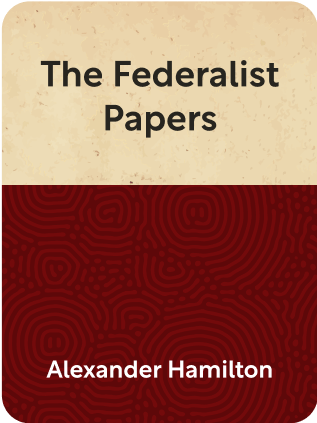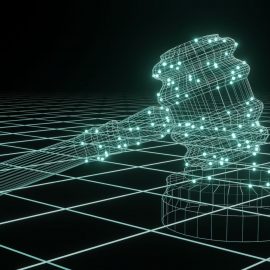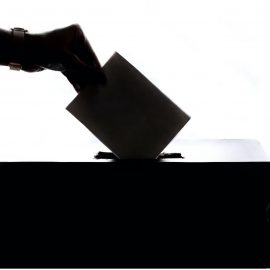

This article is an excerpt from the Shortform summary of "The Federalist Papers" by Alexander Hamilton. Shortform has the world's best summaries of books you should be reading.
Like this article? Sign up for a free trial here .
What are the three branches of government? How did Federalist 47 support this structure under the new U.S. Constitution?
The three branches of government are executive, legislative, and judicial. Federalist 47 discusses the separation of powers across the branches.
Read more about the three branches of federal government and how they were discussed in Federalist 47.
What Are the Three Branches of Federal Government?
All constitutional forms of government have the same basic structure. The three branches of federal government: executive, legislative, and judicial branches.
- The legislative branch, which writes the laws;
- The executive branch, which enforces the laws; and
- The judicial branch, which interprets the laws.
A basic principle of republicanism is that the executive, legislative, and judicial functions must remain separate. Critics of the new Constitution argued that its provisions for the separation of powers were too weak and that the result would be a corrupt despotism.
But instead of striving for complete separation of powers between the executive, legislative, and judicial branches (which was an impossibility), it was far more important to imbue the Constitution with the principle of checks and balances.
The new Constitution was well-designed with a robust system of checks and balances to ensure that the branches remained coequal, that none reigned supreme over the others, and that each had the means to hold the others in check.
The House of Representatives
The first of the three branches is the legislative, which includes the House of Representatives. There are few eligibility requirements for election to the House. A member merely needs to:
- Be age 25 or older
- Be a resident of the state they represent
- Have been a citizen for at least seven years prior to their election
- Hold no other office during their tenure in the chamber
Beyond these requirements, anyone is eligible to run and serve (although the House retains the right to expel members by a two-thirds vote). Members of the House were to be directly elected to two-year terms by the voters of the state, with voters meeting the same eligibility requirements that they did for state legislative elections.
Because apportionment in the House was to be determined by state population, the larger states would naturally hold sway.
It was to have sole authority to impeach members of the executive branch, including the president, for high crimes and misdemeanors—a crucial check on executive power.
The Senate
The other half of the first of the three branches is the Senate. The Senate is the upper chamber of the national legislature. Unlike the House, its members must be 30 years of age and have been citizens of the United States for nine years prior to their election. Thus, senators would tend to be older, more experienced, and have greater familiarity with the laws and customs of the United States than their counterparts in the House.
Senators were to serve six-year terms and be elected by the state legislatures—not by the people themselves. Each state was to have two senators, regardless of population. Naturally, the Senate conferred an advantage on smaller states, who received disproportional representation in the upper chamber relative to their actual number of voters.
The Senate was designed to temper the more dangerous democratic impulses of the House. This was because its members were fewer, they were not elected directly by the people, and their terms in office would be longer. This would prevent them from being susceptible to democratic political pressures.
(Shortform note: The system of having state legislatures elect senators had become rife with corruption by the late-19th century, with scandalous incidents of Senate seats being openly bought and sold. Moreover, the political polarization of the time had frequently resulted in state legislatures failing to come to agreement on elections to the Senate. This resulted in many Senate seats going unfilled, leaving states without representation in the upper chamber of Congress. The Seventeenth Amendment to the Constitution, ratified in 1913, finally ended senatorial election by state legislatures, mandating instead that senators be directly elected by the voters of their states.)
The Senate, as the upper chamber, was designated with certain special privileges. One of the most important of these was its sole prerogative, via a two-thirds vote, to ratify treaties negotiated and submitted to it by the President. The Senate would also be responsible for approving all cabinet appointments submitted by the president. These were both powerful checks on the executive branch.
Another, arguably more important check on the power of the executive branch was the Senate’s sole authority to convict members of the executive (including the president) for high crimes and misdemeanors by a two-thirds vote, following impeachment in the House.
The Presidency
The presidency, the chief executive of the federal government, was perhaps the most controversial and hotly contested feature of the Constitution. The president would have the power to:
- Veto bills passed by both houses of Congress, thus serving as an important check on legislative power;
- Propose legislation;
- Negotiate treaties;
- Nominate executive officials and federal judges;
- Make temporary appointments when Congress was not in session;
- Adjourn Congress when it could not agree on a time of adjournment;
- Issue pardons, except in cases of impeachment; and
- Direct and oversee the armed forces as commander-in-chief
Anti-Federalist critics argued that these powers rendered the office tantamount to a monarch. But, in reality, the office’s authority was heavily restricted by the provisions of the Constitution. The president’s veto could be overridden by a two-thirds majority vote in each house of Congress; treaties and executive appointments required Senate approval; he could not pardon offenders who’d been impeached; and he could not declare war or raise funds for an army without Congress.
The Final of the Three Branches: Judiciary
The third of the three branches of federal government, the judiciary, is unique. Unlike the executive branch, it possesses no army, navy, or other powers of enforcement to compel adherence to its decisions. Unlike the legislature, it has no direct power of the purse.
Instead, the way that the federal courts exercise this power is through judicial review. This is the power of the courts to declare null and void those laws or executive orders that are in violation of the Constitution. Judicial review serves as a powerful check on both the executive and legislative branches. While courts generally do not have many formal powers to enforce their rulings, Congress and the president have historically complied with court orders, even when they disagreed with them.
Given its crucial function, and judges’ comparative lack of enforcement power, it was important that the judiciary be independent from the executive and legislative branches. To ensure this, judges were to serve for life, provided that they maintained “good behavior” on the bench. There were good reasons for this. Judges were meant to make their rulings solely on the Constitution, not for political considerations. If they had to be renominated and re-confirmed, they might feel the need to curry favor with Congress and the president, which could exert a corrupting influence on their jurisprudence.
The highest court in the land was to be the United States Supreme Court. In the main, the Supreme Court acted as an appellate court—issuing final rulings (for those cases it chose to hear) on cases that had worked their way through the inferior federal courts. The only cases where the Supreme Court would have original jurisdiction would be cases involving ambassadors or cases in which a state was a party to a suit.

———End of Preview———
Like what you just read? Read the rest of the world's best summary of Alexander Hamilton's "The Federalist Papers" at Shortform .
Here's what you'll find in our full The Federalist Papers summary :
- The genius of the founding fathers in how they designed the United States Constitution
- Why it was critical for the United States to form a union rather than stay separated as colonies
- How Alexander Hamilton anticipated social issues that are still relevant today






